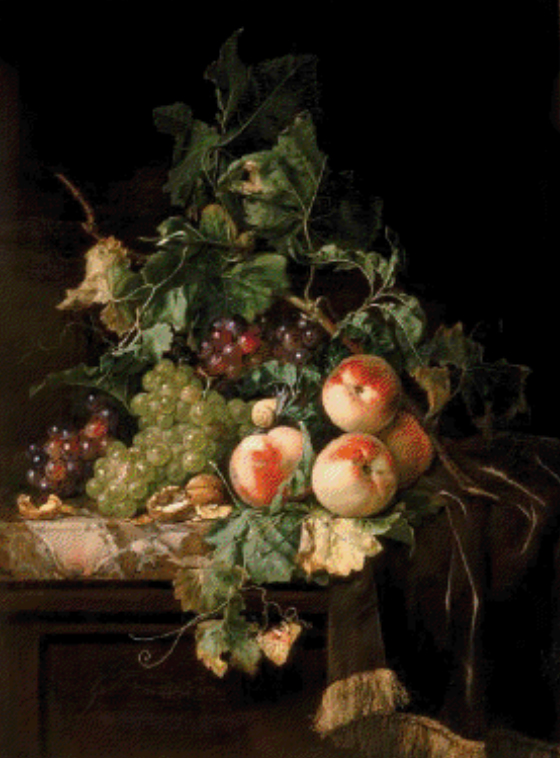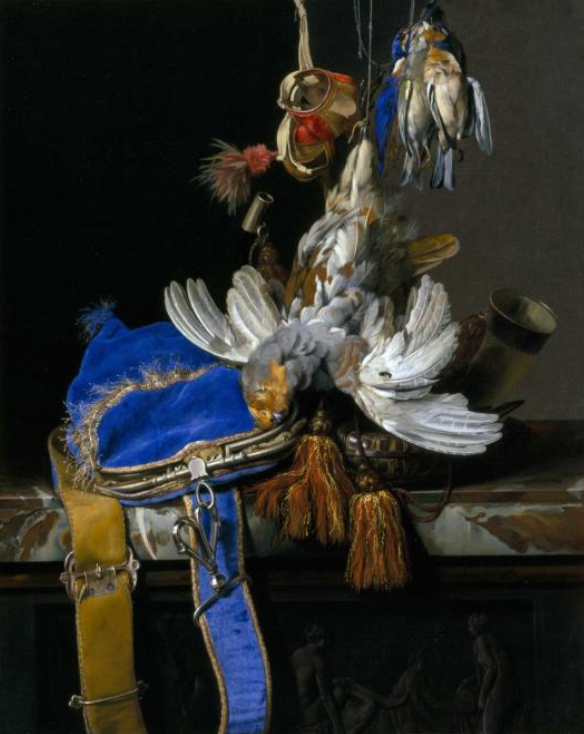藝文新聞
回首頁 |
|
First-Ever Exhibition Devoted to 17th-Century Dutch Painter Willem van Aelst Premieres at the Museum of Fine Arts, Houston
(01/03/2012)
First-Ever Exhibition Devoted to 17th-Century Dutch Painter Willem van Aelst Premieres at the Museum of Fine Arts, Houston, March 2012 and Travels to the National Gallery of Art, Washington, D.C.
Unprecedented Exhibition Reveals Painting Newly Attributed to Van Aelst
Houston—January 2012—The first-ever monographic exhibition of Dutch still-life painter Willem van Aelst (1627-1683) premieres at the Museum of Fine Arts, Houston (MFAH), March 11–May 28, 2012. Co-organized by the MFAH, the National Gallery of Art, Washington, and the Sarah Campbell Blaffer Foundation, Elegance and Refinement: The Still-Life Paintings of Willem van Aelst features 28 of the artist’s finest works culled from private and public collections in the United States and Europe.
Recognized as one of the leading painters in the Dutch Republic during the “Golden Age” of Dutch painting, he was largely forgotten by the 19th century. The exhibition aims to restore Van Aelst’s stature by showcasing his technical brilliance, attention to detail and ingenious brushwork for 21st-century audiences to discover.

Willem van Aelst, Dutch 1627 – after 1687. Still Life with Fruit, Walnuts, and Insects on a Marble Ledge, 1670. Oil on canvas. Private Collection
“Van Aelst’s luxuriant compositions, rich in detail, bring to life the elegant tabletop settings of the 17th century. Over two dozen of his detailed, vibrant paintings will be on view, filled with sumptuous fabrics, elegant stone tables, ripe fruit, artfully arranged hunting trophies and brilliant platters, cups, watches, armor and more,” said James Clifton, Director of the Sarah Campbell Blaffer Foundation and Curator of Renaissance and Baroque Painting at the MFAH. “Also on view will be a large-scale painting, long credited to artist Willem Kalf, which was recently reattributed to Van Aelst during a technical examination by a National Gallery of Art conservation scientist. Within the exhibition, the painting will be rightly reunited with other works from the artist’s oeuvre.”
Elegance and Refinement is co-curated by Clifton and Arthur Wheelock, Curator of Northern Baroque Painting at the National Gallery of Art. The project was conceived by Tanya Paul, Ruth G. Hardman Curator of European Art at the Philbrook Museum of Art in Tulsa, following her Ph.D. dissertation on the artist and was developed while she was a curatorial fellow at the Sarah Campbell Blaffer Foundation in Houston. Following Houston, the exhibition will be presented at the National Gallery of Art June 24–October 14, 2012. A hardcover, illustrated catalogue of the same title, published by Skira Rizzoli in association with the MFAH, accompanies the exhibition. It is the first book dedicated solely to Van Aelst’s oeuvre and contains essays by Clifton, Wheelock, Paul and Julie Berger Hochstrasser, as well as an essay by conservators and conservation scientists, Melanie Gifford, Anikó Bezur, Andrea Guidi di Bagno and Lisha Deming Glinsman.
About the Exhibition
The paintings in the exhibition cover the range of the artist’s career and are culled from collections including the Sarah Campbell Blaffer Foundation (permanently on view at the MFAH) and the National Gallery of Art. Five paintings will be on loan from the Galleria
Palatina at the Palazzo Pitti in Florence, which holds the largest concentration of Van Aelst’s work since it was collected extensively by the Medici court and later transferred to state collections. Others works have been lent by the Staatliche Museen zu Berlin; The Fitzwilliam Museum, Cambridge; Liechtenstein Museum, Vienna; Mauritshuis, The Hague; and The Fine Arts Museums of San Francisco.

Willem van Aelst, Dutch, 1627 – after 1687. A Still Life with Game and Blue Velvet Game Bag on a Marble Ledge, c. 1665. Oil on canvas. Sarah Campbell Blaffer Foundation, Houston
Dutch artists tended to specialize in specific areas (with Rembrandt being an unusual exception to this rule), and Van Aelst focused on two basic pronk (display) subjects: game still lifes and fruit and flower still lifes. The oil paintings were intended to convey the aura of patrician life and were often executed for wealthy patrons. The exhibition will feature a range of the artist’s best pronk paintings, lush with imported fruits; luxurious, elaborate silver-gilt objects; beautiful floral displays; and “hunting trophies” such as dead fowl, hares and other animals. Van Aelst’s works often feature marble tabletops with stone relief designs on the support. Three of the game pieces in the exhibition depict the story of the goddess Diana and her nymphs bathing. The subject was particularly appropriate for hunting images because, according to the ancient story, the hunter Actaeon stumbled into Diana’s sacred grove, and she cursed him for seeing her naked - she turned him into a stag and he was torn to pieces by his own dogs. Van Aelst’s depiction of Diana’s bath derived from a composition by the goldsmith Paulus van Vianen, and his version of the subject on a silver plaquette will be exhibited with the paintings.
The centerpiece of the exhibition will be two large-scale paintings, each measuring over six feet high and painted during Van Aelst’s sojourn in Italy, featuring unusual subject matter geared toward pleasing his patrons. Pronk Still Life with Fruit and Game (1654) was painted for Cardinal Leopoldo de’ Medici. It includes an abundance of opulent objects overflowing the canvas, including a nautilus cup on a stone table with a rich blue tablecloth, likely painted using expensive ultramarine pigment made from lapis lazuli (a stone prized in the Medici collections). The cup and pitcher in the painting allude to Medici collection objects: the hunting bag, rifle, crossbow and dead birds refer to Leopoldo’s hunting hobby; and the violin and bow allude to the patron’s love of music. The five senses are also evoked through the depictions of fruit for smell and taste; velvet and bird feathers for touch; a violin for sound; and luxury objects for sight. A centrally located, open pocket watch may have been intended to reference time or even the timelessness of the painting and shows off Van Aelst’s meticulous attention to detail and ability to create a finely finished surface.
The reattributed work, Pronk Still Life of Armor from around 1651, depicts rich fabrics and luxury metalwork objects mingled with arms and armor, all artfully scattered over a stone table and velvet upholstered chair. The painting has long been attributed to Rotterdam master Willem Kalf, but a new technical examination carried out for this exhibition and catalogue by a National Gallery of Art conservation scientist has confirmed that it is, in fact, a work by Van Aelst. Although the armor is an atypical subject for the artist, the painting is full of trademark Van Aelst flourishes: an excess of fringed decoration, rich colors typical of the Paris compositions, highlights suggested with dabbled paint and even a previously overlooked partial monogram on a medal with the letters “VA.” This work is the artist’s most complex from the Paris period and was likely commissioned by René II de Froulay, Comte de Tessé, with the weapons an indicator of the Comte’s military career.
About the Artist
Van Aelst was born in Delft in 1627 and apprenticed as a painter with an uncle who had associations with the court of the Princes of Orange in The Hague. At 16 he was admitted into the Guild of St. Luke but left shortly thereafter to travel south to France and Italy. This decade- long sojourn was unusual for an artist from the Netherlands and greatly impacted his career.
Van Aelst spent some five years in Paris immersed in the artistic community of Saint-Germain- des-Près, where he was influenced by the Flemish-born painter and dealer Jean Michel Picart (c.1600-1682). Picart’s knowledge of the Parisian art market provided Van Aelst with an impetus to refine his style, adapting a harder, finer finish and employing the use of high-quality, expensive pigments such as ultramarine. Van Aelst next traveled to Italy where he was introduced to the Medici court in Florence where Cardinal Giovan Carlo Medici and his brother, Cardinal Leopoldo de’ Medici became his patrons. He worked briefly in Rome as well, but his career there came to an abrupt halt when a fight with a Frenchman forced Van Aelst to flee the city to avoid prison.
Van Aelst finally settled in Amsterdam in 1657 and also found a successful market for his work in his home country. Almost 30 years old, he returned as an experienced and valued artist and was able to pay off debt owed for rent and wine expenses. In Amsterdam he also amassed enough wealth to purchase a home along the Keizergracht, one of the most exclusive streets in the city. He married, had two children and took on two pupils of his own—one who is also renowned today: Rachel Ruysch. Van Aelst died in 1683.
Credits
This exhibition is organized by the Museum of Fine Arts, Houston, the National Gallery of Art, Washington, and the Sarah Campbell Blaffer Foundation. Generous funding is provided by Ms. Ann G. Trammell.
The exhibition is also supported by an indemnity from the Federal Council on the Arts and the Humanities.
The catalogue for this exhibition receives generous funding from the Netherland-America Foundation.
Upcoming Exhibitions at the MFAH Revelation:
The Major Paintings of Jules Olitski February 12–May 6, 2012 Elegant Perfection: Masterpieces of Courtly and Religious Art from the Tokyo National Museum February 17-April 6, 2012 Shifting Paradigms in Contemporary Ceramics: The Garth Clark and Mark Del Vecchio Collection March 4–June 3, 2012 Utopia/Dystopia: Construction and Destruction in Photography and Collage March 11– June 18, 2012
MFAH Collections
Founded in 1900, the Museum of Fine Arts, Houston, is among the ten largest art museums in the United States. Located in the heart of Houston’s Museum District, the MFAH comprises two gallery buildings, a sculpture garden, library, theater and two art schools, with two house museums, for American and European decorative arts, nearby. The encyclopedic collection of the MFAH numbers some 63,000 works and embraces the art of antiquity to the present.
( 回首頁 Houston eWIND )
|
|
. |


